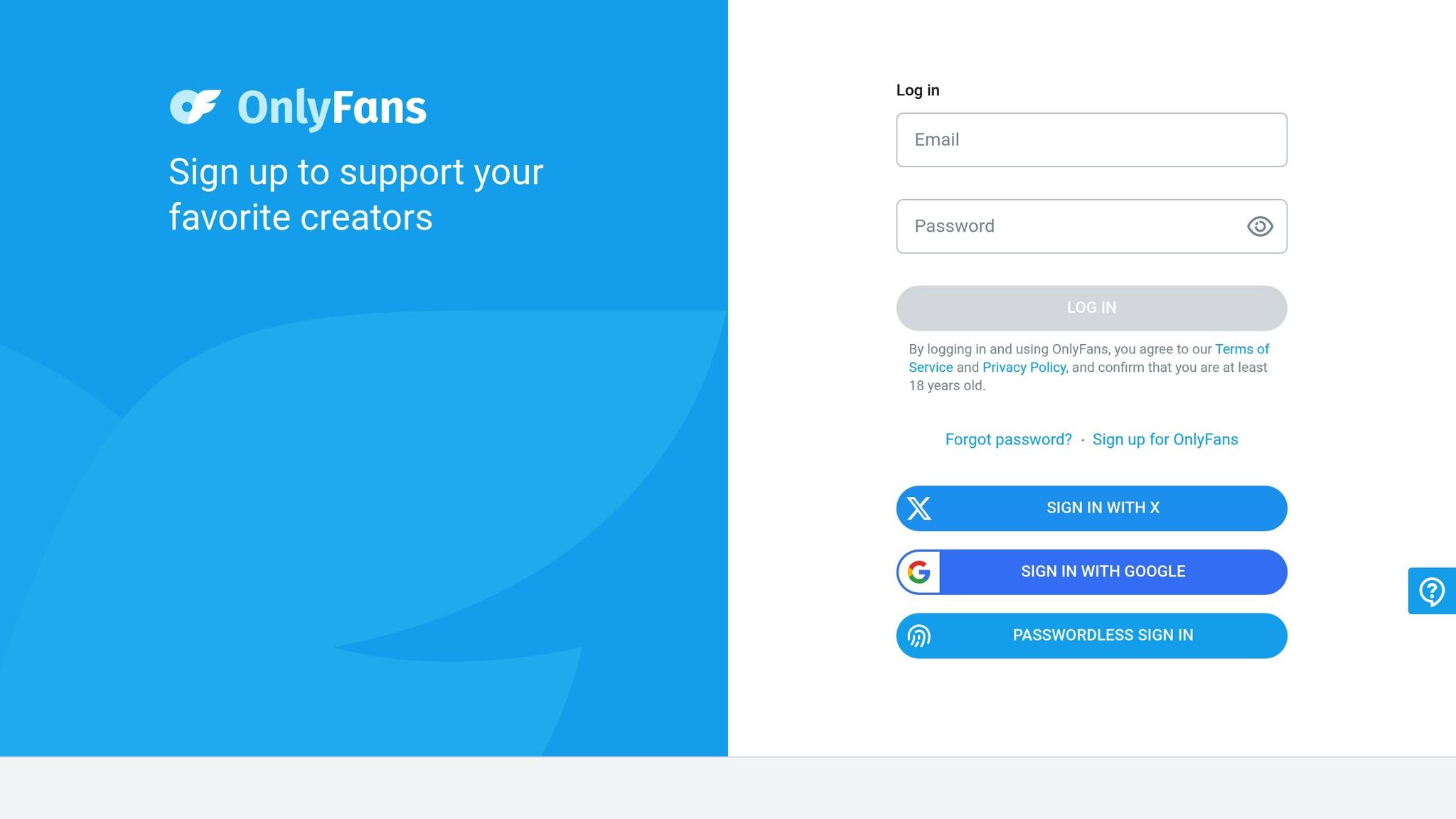Choosing the right revenue model for your OnlyFans agency can impact how much you earn, how predictable your income is, and how appealing your services are to creators. Here’s a quick breakdown of the three main models:
- Commission-Based: You take a percentage (e.g., 20–50%) of a creator’s earnings. This aligns your income with their success but can be unpredictable.
- Fixed Subscription Fee: Creators pay a set monthly fee (e.g., $500), giving you steady income, but limits your earning potential.
- Hybrid: Combines both – a base fee plus a smaller commission. Offers stability and room for growth but requires careful pricing.
Each model has pros and cons, depending on the creators you work with and your business goals. For example, commission-based works well with high-earning creators, while fixed fees are better for steady cash flow. Hybrid models balance both but can be harder to manage.
Quick Comparison:
| Model | Pros | Cons | Best For |
|---|---|---|---|
| Commission-Based | Scales with creator earnings | Unpredictable income | Agencies with growth-focused creators |
| Fixed Subscription Fee | Predictable income | Limited earning potential | Agencies needing steady cash flow |
| Hybrid | Stability + growth potential | Complex to manage | Agencies with diverse creator profiles |
Your choice should reflect your agency’s financial needs and the creators you aim to attract. Always monitor metrics like earnings and retention to refine your approach over time.
OnlyFans Management: How to Propose the Right Revenue Split to Your Models

1. Commission-Based Revenue Model
The commission-based revenue model ties an agency’s earnings directly to a percentage of a creator’s income, making the agency’s success closely aligned with the creator’s performance.
How It Works
The commission rate is mutually agreed upon by the agency and the creator, depending on the range of services offered. Once the creator earns revenue, the agency takes its share by applying the agreed-upon percentage to the total earnings.
Earnings Potential
This model grows alongside the creator’s income. However, revenue can fluctuate due to factors like content performance, audience engagement, and seasonal trends, making it less predictable.
Cost Predictability
For creators, this model eliminates upfront costs, making it an accessible option. That said, the variability in earnings can make it trickier for agencies to predict monthly revenue, requiring careful cash flow management.
Scalability
As creators’ earnings increase, so does agency revenue – without the need to renegotiate fees. This dynamic encourages agencies to invest in marketing and content support to help creators thrive.
Best Creator Profiles
This approach works well for creators who have steady income streams or show strong growth potential. It may not be the best fit for creators with modest earnings who require intensive daily management. Up next, we’ll dive into another revenue model that offers a different set of advantages for OnlyFans agencies.
2. Fixed Subscription Fee Model
The fixed subscription fee model is based on a monthly retainer, where creators pay agencies a set fee regardless of how much they earn. Instead of tying compensation to performance, this model provides a stable and predictable income stream for agencies, making it a stark contrast to commission-based systems.
How It Works
Agencies charge a flat monthly fee that covers a range of services, such as content strategy, marketing, and other management tasks. Payment is typically made at the start of each billing cycle, ensuring agencies maintain a steady cash flow, no matter how well – or poorly – a creator performs financially.
Earnings Potential
This model guarantees consistent monthly revenue, making financial planning easier for agencies. However, the earning potential is limited compared to commission-based models. For example, an agency managing 20 creators at $500 per month would generate $10,000 in steady income. But even if one of those creators experiences a surge in earnings, the agency’s revenue remains fixed.
Cost Predictability
Both agencies and creators benefit from knowing exactly what to expect financially. Agencies can rely on consistent income to cover their operating expenses, while creators can plan their budgets without worrying about unpredictable commission fees cutting into their profits. This stability allows agencies to focus on covering fixed costs and planning for growth.
Scalability
Scaling this model depends entirely on acquiring new clients since revenue per creator remains fixed. Unlike commission-based structures, where increased creator earnings automatically boost agency revenue, fixed fees require agencies to actively grow their client base. This means a strong focus on sales and marketing is essential to keep the pipeline of new creators flowing.
Best Creator Profiles
This model is particularly suited for newer creators who require hands-on support but haven’t yet built significant income streams. It also appeals to creators who value predictable expenses and prefer standard management services without worrying about a percentage of their earnings being deducted. Established creators may also find this model attractive if they’re looking for straightforward management rather than aggressive growth strategies.
sbb-itb-bd3d2dc
3. Hybrid Revenue Model
The hybrid revenue model combines elements of commission-based and fixed-fee structures, offering a balance between predictable income and performance-driven incentives. It pairs a lower fixed monthly fee with a smaller commission percentage, creating a system that works for both stability and growth.
How It Works
In this model, agencies charge creators a base monthly fee alongside a reduced commission on their earnings. For instance, an agency might charge $500 per month as a base fee, plus a 10% commission on all earnings. This setup ensures agencies receive a guaranteed income while still benefiting from the creator’s success.
Earnings Potential
The hybrid approach offers agencies a steadier income compared to a pure commission model and greater earning potential than a fixed-fee structure. For example:
- If a creator earns $8,000 in a month, the agency would collect $1,300 ($500 base fee + $800 commission).
- For a month with $20,000 in earnings, the agency’s revenue increases to $2,500 ($500 base fee + $2,000 commission).
This structure helps agencies cover their fixed costs while still reaping the rewards of increased creator performance.
Cost Predictability
This model benefits both agencies and creators by offering a more predictable financial setup. Agencies can rely on the base fee to manage operational expenses, while creators benefit from lower commission rates compared to commission-only models. Additionally, the performance-based component ensures fees adjust based on income, making it less burdensome during slower months.
Scalability
The hybrid model supports scalability by allowing agencies to grow revenue in two ways: onboarding new creators and helping existing creators boost their earnings. The base fee provides a steady income stream that agencies can reinvest in growth efforts, while the commission rewards them for improving creator performance.
Best Creator Profiles
This model is ideal for agencies working with a mix of creators at varying stages in their careers. It appeals to creators seeking predictable costs with performance-based benefits. Established creators enjoy the lower commission rates, while newer creators avoid the high upfront costs of fixed fees, giving them room to grow. However, the hybrid model can be more challenging to explain and manage. It may also be less affordable for creators who are just starting out and haven’t yet achieved steady revenue streams.
This balanced structure offers a middle ground, making it a versatile option for agencies and creators alike.
Pros and Cons Comparison
This comparison breaks down the strengths and weaknesses of each revenue model, helping agencies evaluate which approach aligns best with their business goals and target audience.
| Revenue Model | Pros | Cons |
|---|---|---|
| Commission-Based (10-30%) | • No upfront costs for creators • Unlimited earning potential • Scales easily with successful creators • Growth tied directly to performance |
• Income can fluctuate monthly • Risk of no revenue during slow periods • Difficult to plan operational budgets |
| Fixed Subscription ($500-$5,000/month) | • Predictable and steady revenue • Simplifies financial planning • Consistent cash flow • Transparent fee structure |
• High initial cost may deter new creators • Limits potential earnings for the agency |
| Hybrid (Base fee + reduced commission) | • Balances risk and reward • Offers more stability than pure commission • Attracts creators at various growth stages • Covers fixed expenses while rewarding performance |
• Requires a carefully crafted pricing strategy to succeed |
The commission-based model is ideal for agencies working with newer creators who may not be ready to pay upfront fees. However, this model comes with risks: if a creator’s monthly earnings drop from $10,000 to $3,000, the agency’s revenue would shrink from $2,000 to just $600.
On the other hand, fixed subscription fees provide financial stability and make budgeting easier. This model is particularly well-suited for agencies collaborating with creators who consistently generate high revenue.
The hybrid model blends the two approaches, offering a base fee alongside a smaller commission rate. For example, an agency charging $500 per month plus a 10% commission would earn $1,300 from a creator generating $8,000 in revenue.
Each model serves different agency needs and financial strategies. Agencies with limited cash reserves might lean toward fixed fees for their predictability, while those comfortable with income variability could prefer commission-based models to maximize earnings during high-performing months. Ultimately, the best choice depends on factors like the agency’s target creators, the scope of services offered, and its financial goals. As the business grows, agencies should remain flexible and ready to adjust their revenue models accordingly.
Conclusion
Choosing the right revenue model for your OnlyFans agency isn’t a one-size-fits-all decision – it comes down to understanding your agency’s unique situation and the creators you work with. Commission-based models are a great fit for agencies just starting out or partnering with newer creators who may not have the means to pay upfront fees. On the other hand, fixed subscription models offer the financial consistency that established agencies often need to manage operations and plan budgets. For those aiming to strike a balance between risk and growth, hybrid models can be a smart choice.
When deciding, think about both your agency’s resources and the type of creators you represent. Smaller agencies or creators who are just beginning might benefit from predictable commission-based or subscription setups that avoid hefty upfront costs. Meanwhile, larger agencies and experienced creators can take advantage of models that reward performance, even if income varies over time.
Don’t forget to regularly monitor key metrics like creator earnings, profit margins, and retention rates. These insights help fine-tune your pricing strategy as your agency evolves. Tools like NimbusReach’s analytics and the Fan Devotion Score can help you identify top-performing creators – the ones who often drive the majority of your revenue. Focusing on these high-return creators can make a big difference in your agency’s success.
Ultimately, a well-aligned revenue strategy – one that matches your operational needs and creator performance – is essential for thriving in the competitive OnlyFans market. And remember, your pricing model isn’t set in stone. The most successful agencies are those that adapt and refine their approach as they grow and learn more about their creators.
FAQs
What’s the best way for an OnlyFans agency to choose a revenue model that fits its goals and creators?
To select the best revenue model, an OnlyFans agency should begin by clearly defining its financial objectives, assessing its available resources, and understanding the unique needs of its creators. A commission-based model is a strong choice for agencies aiming to grow alongside their creators, as it ties the agency’s earnings directly to the creator’s success. On the other hand, a hybrid model offers a mix of consistency and adaptability, making it a good fit for agencies managing creators with varied income sources.
It’s also important to factor in the agency’s size, the niche its creators operate in, and expected engagement levels. By carefully analyzing these aspects, an agency can craft a revenue strategy that supports steady growth while maximizing earnings for both the agency and its creators.
What should agencies consider when deciding on a commission percentage or fixed fee for their revenue model?
When deciding on a commission percentage or a fixed fee, agencies need to weigh several important factors to find the right balance. These include the agency’s experience and reputation, the creator’s earning potential, and the specific services being offered, such as marketing, content creation, or account management. Other considerations include the complexity of the content, the time investment required for production, and the overall value delivered to the creator’s audience.
Commission rates often fall between 10% and 30%, varying based on the level of support provided and the creator’s income potential. It’s also essential for agencies to align their revenue model with their objectives, resources, and the partnerships they establish with creators. This ensures a fair and workable arrangement that benefits both sides.
What’s the best way for an agency to manage a hybrid revenue model while ensuring stability and growth?
Balancing a hybrid revenue model means managing diverse income streams like subscriptions, commissions, and value-added services. This approach spreads risk and helps create a more stable financial foundation by avoiding over-reliance on one source of revenue.
To keep operations running smoothly, it’s smart to use tools that handle billing efficiently, track performance metrics, and provide clear analytics. Regularly analyzing revenue and expenses is also key – it uncovers trends, highlights opportunities to allocate resources better, and pinpoints the most profitable areas. By staying flexible and focused on data, agencies can achieve steady growth while keeping their finances on solid ground.
Related Blog Posts
- OnlyFans Agency Strategies: What Top Competitors Do
- How to Scale Your OnlyFans Agency From 1 to 50 Creators
- Commission Structures for OnlyFans Agencies: What Works Best? Legal Considerations Before Launching an OnlyFans Management Agency How to Pay Creators in Your OnlyFans Agency Without Headaches The Best Tools for Running a Successful OnlyFans Agency Top Software Solutions for OnlyFans Agencies in 2025 NimbusReach vs Modash: Which Tool Is Better for Finding Creators? CRM for OnlyFans Agencies: How to Stay Organized and Scale
- How Much Do OnlyFans Agencies Really Make?





